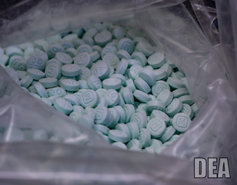What Is the Scope of Fentanyl Use Today?

Fentanyl, a high-strength opioid first manufactured to treat very specific medicinal applications, is now a widespread drug of choice that causes more overdose deaths than all other types of drugs combined. Even when people who experiment with drugs make a conscious effort to avoid fentanyl, they often end up consuming it anyway, as dealers mix the potent opioid into other drugs and then sell it as heroin, cocaine, or counterfeit pills.
As fentanyl continues to spread across the U.S., everyone who struggles with addiction is at extremely high risk.
What Is Fentanyl?
Fentanyl is a high-strength opioid intended to treat severe pain, such as high-intensity acute pain following surgery, or chronic pain, such as cancer pain or palliative pain. The drug was created with the intent of helping patients who were physically tolerant of other opioids.

A synthetic opioid made in a lab (not derived from the opium poppy plant), fentanyl is one of the most potent opioid drugs available, anywhere from 50 to 100 times more potent than morphine and about ten times more potent than heroin. Initially, drug dealers got ahold of pharmaceutical-made fentanyl and mixed it with other drugs such as heroin, cocaine, meth, and MDMA to make those substances more addictive. However, as dealers observed how much money they could make selling fentanyl-spiked drugs, they began finding ways to mass-produce synthetic fentanyl in clandestine lab operations.
Today, law enforcement departments in all fifty states have seized batches of drugs, tested them, and found them positive for fentanyl contamination.
What Are the Effects of Fentanyl?
Fentanyl affects the body in a very similar way as other opioids. The drug binds to the opioid receptors in the brain, numbing pain and eliciting a dreamlike state of dulled euphoria. After using fentanyl a few times, addicts’ brains adapt to the drug, which diminishes sensory sensitivity and makes it more difficult for such individuals to feel pleasure and pleasant sensations from anything besides the drug.
In the short term, some of the effects of using fentanyl include:
- Nausea
- Sedation
- Confusion
- Drowsiness
- Constipation
- Unconsciousness
- Extreme happiness
- Problems breathing
Fentanyl is extremely addictive, so much so that when users try to stop using it, even if they’ve only used it a few times, they’re likely to experience withdrawal symptoms like:
- Sleep problems
- Severe cravings
- Muscle and bone pain
- Diarrhea and vomiting
- Cold flashes and goosebumps
- Uncontrollable leg movements
An Overdose: The Most Dangerous Effect of Fentanyl

The most dangerous side effect of fentanyl use is an overdose, and because fentanyl is so potent, it only takes a very, very small amount of the drug to cause an overdose. Further, because dealers often mix cheap fentanyl into other drugs to boost profits, users have no way of knowing if the drug they’re purchasing (meth, cocaine, heroin, “prescription pills”) has fentanyl in it.
Sadly, the spread of fentanyl into the drug supply and the surge in dealer-made fentanyl and similar synthetic opioids has led to a sharp increase in drug overdoses. According to the Centers for Disease Control and Prevention (CDC), about 150 people die in the U.S. every day from fentanyl overdoses or from overdoses on synthetic opioids that are extremely similar in their chemical composition to fentanyl.
According to the National Institute on Drug Abuse (NIDA), more than 106,000 people died from drug overdoses in the U.S. in 2021, with about 70,601 of those deaths being attributed to fentanyl or synthetic opioids like fentanyl. To further put that figure into perspective, all opioids combined (heroin, prescription painkillers, methadone, synthetic opioids, and fentanyl) caused about 80,000 deaths in 2021, with fentanyl causing over 88% of those deaths. NIDA concluded its report by naming fentanyl as being the main driver of the nearly 7.5-fold increase in drug overdose deaths that occurred in the U.S. between 2015 and 2021.
How Widespread Is Fentanyl Use?

CDC and NIDA data show that overdoses from fentanyl comprise a significant majority of all drug overdoses occurring in the U.S. today, but how widespread is fentanyl use? According to data published by NYU School of Global Public Health, more than 80% of a group of injection drug users in New York City tested positive for fentanyl, even though just 18% said they had intended to use fentanyl.
The NYU data are quite alarming. According to the findings, fentanyl was the most common drug found on drug tests administered to 300 IV drug users. About 83% of the users tested positive for fentanyl. Within that group, 46% tested positive for fentanyl and heroin, and 56% tested positive for just fentanyl. When asked about their drug use habits, a majority of the 300 drug users examined in the study said their drug of choice was heroin and that they were trying to use heroin, not fentanyl.
The NYU research has produced two alarming conclusions:
1. Fentanyl use is becoming extremely widespread.
2. People who struggle with addiction are putting fentanyl into their bodies even when they are not intending to do so.
The Need for Fentanyl Addiction Treatment
As the major contributor to the increasing drug-related death rate on full display in hospitals and morgues across America, fentanyl addiction is cause for alarm. When people use this drug, whether they mean to or not, they risk their lives. Any exposure to fentanyl, even just traces of the drug, can be fatal.
Thankfully, qualified residential addiction treatment programs possess the tools and know-how to help fentanyl addicts overcome their addiction and start writing a new chapter. If you know someone who uses drugs and cannot stop, please help them enter treatment. Even if fentanyl is not their drug of choice, they’re still at risk of using a drug that has been contaminated with fentanyl. Please help them enter a qualified drug rehab center before it is too late.
Sources Cited:
- NIDA. “What is fentanyl?” National Institute on Drug Abuse, 2021. nida.nih.gov
- CDC. “Fentanyl Facts.” Centers for Disease Control and Prevention, 2023. cdc.gov
- NIDA. “Drug Overdose Death Rates.” National Institute on Drug Abuse, 2023. nida.nih.gov
- S.D. “Understanding intentionality of fentanyl use and drug overdose risk: Findings from a mixed methods study of people who inject drugs in New York City.” Science Direct, 2023. sciencedirect.com


 ®
®